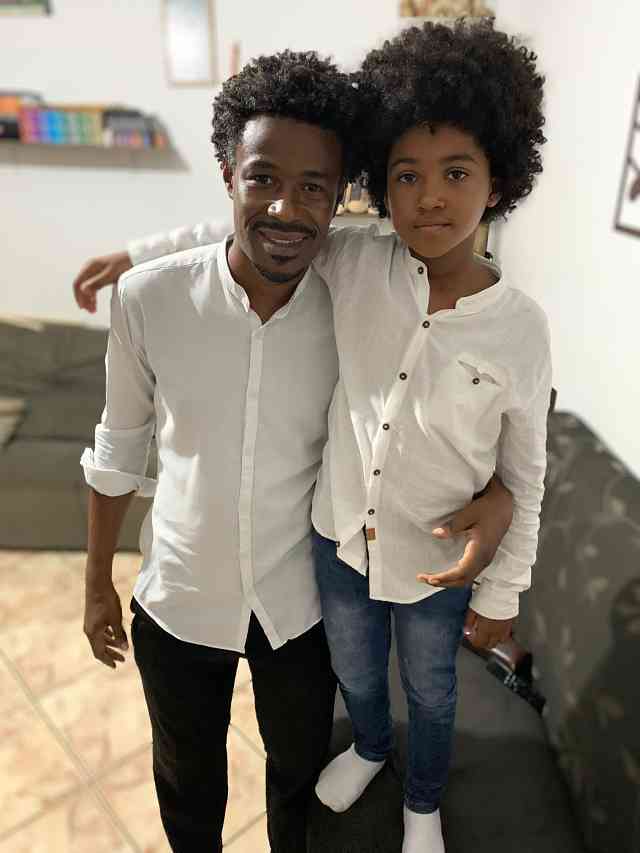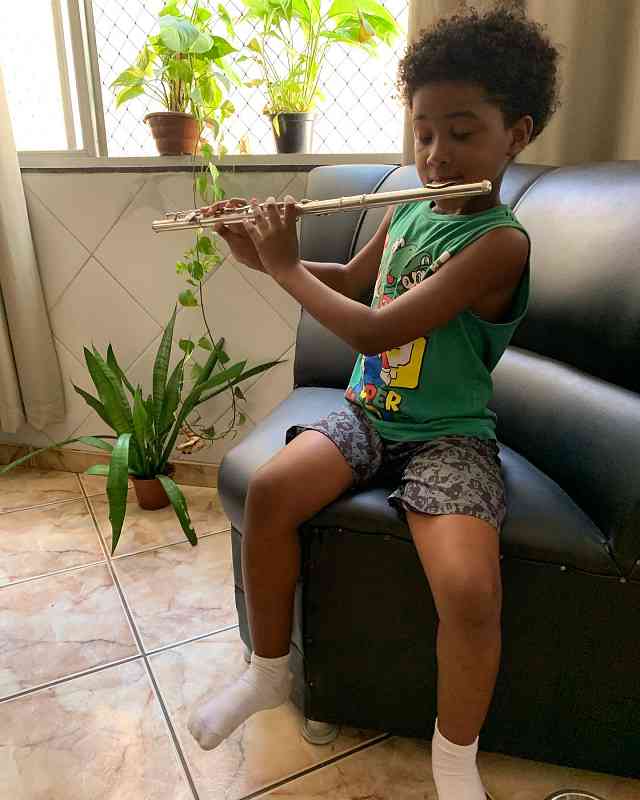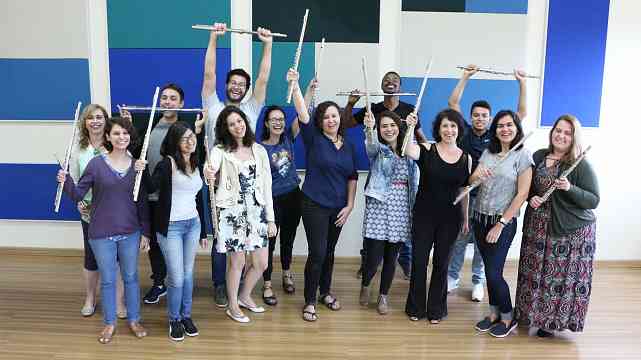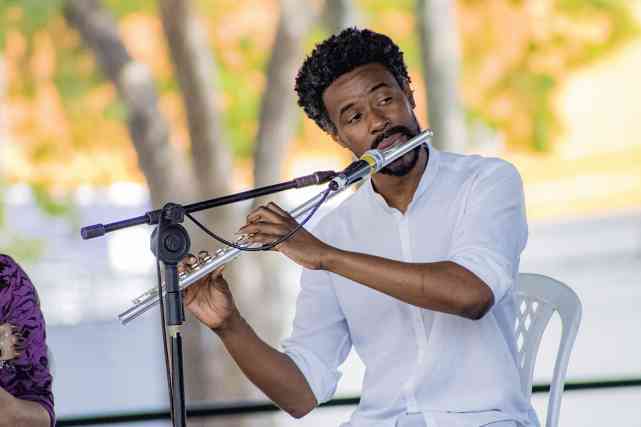
Leandro Candido de Oliveria and his son Murilo.
For over twenty years, the Baccarelli Institute has served the residents of Heliópolis, a community in São Paulo Brazil. Founded as “an agent of social transformation through art,” the Institute provides more than 1,200 children and young people with a holistic music and arts education on an annual basis. In 2018, the Institute hosted Suzuki teacher training for flute for the very first time. In that inaugural Unit One course were ten teachers, including Leandro Candido de Oliveira, a graduate of the Institute who was then on the flute faculty at the school. Mônica Camargo, current head of the Suzuki Wind and Brass department at the Institute, and Viviane Marquez, another former student now on faculty, also audited.
As the instructor for that course, I was deeply impressed by the warmth and sense of community we experienced throughout the eight days that we spent together. The quality of musicianship was exceedingly high; the exit exams were full of beautiful playing, none more so than Leandro’s. On the final day, he invited some of his fellow musicians to perform choro music, a Brazilian popular instrumental music genre, for the class. It was an unforgettable experience, especially when Brasilia participant Samille Bonfim took out her rice canister to use as a shaker, in accompaniment to Pixinguinha’s celebrated work, “Carinhoso.”
After the course, I continued to follow Leandro on Instagram @tigraoflauta, which features his many performances of standards from the choro repertoire, and also some of his own pieces. As he began to teach his son Murilo, I was so inspired to watch the boy’s progress on first the recorder and then the flute. But I was even more fascinated by how Leandro taught Murilo to play by ear, using the language of Brazilian music as a framework. This, surely, is the “mother tongue method” in action!
I thought many teachers and parents would be interested to see and learn more about their work, so Leandro agreed to sit down for an interview. You can also find Murilo’s own Instagram account @muritigrinho, which is lovingly curated by his parents. Like Leandro, Murilo’s mother Jessica is also a professional musician, and the whole family learn and play together in their videos. The following interview was conducted with the gracious coordination of Mônica Camargo, who also translated the questions and responses for this article.
How old is your child now, and at what age did you formally start teaching him music?
My son Murilo was born in 2015, so right now he is eight years old. I started teaching him music when he was four years old.
What were your goals?
My goal at first was to explore the musicality that I already noticed in him since he was a young child. As his mother is also a musician, our house has always been surrounded by many instruments and many musician friends. He was always drawn to musical environments and from a very young age, he began to show a lot of musicality, singing in tune and with rhythm. The recorder was a way for me to develop the musicality he already had within himself. With songs that he sang, I managed, somehow, to translate them to the instrument and show that it was possible to play the sounds he already had in his head.
Do you practice together every day? Does he play or practice alone?
Yes, we practice together and during the pandemic, it was much more intense: it was two years of isolation playing every day, playing with music, finding ways to make music. It was our fun activity, and our way of surviving. Nowadays he practices alone too, and he works things out by himself. If he watches a cartoon that has music, he takes the flute and plays along. He still doesn’t have the discipline to resolve difficulties, but when he has it in his mind that he wants to play, he spends the whole day playing.

Murilo practicing flute at home.
Please tell me more about how and why you teach Murilo to play choro.
Well, I come from the universe of choro, which is a regional, instrumental genre, and is considered the first genuinely Brazilian music. The most effective form of learning it is by ear, listening to recordings and interpretations of other musicians. The score is in the background—it serves more as an annotation.
I always noticed that musicians who started very young with choro had a musical fluency above the ordinary, partly because the melodic structure of choro is very harmonically based. For example, if a choro has three parts, each part has a different tonality with modulations, so the melody itself shows the whole harmonic path. Even without formally knowing about harmony, your ear is already feeling the harmony within the melody, apart from the rhythmic difficulties of the music.
It’s a form of music in which I really believe promotes the possibility of developing a keen perception of a musical whole. And after I studied the Suzuki Method a bit, where it says to observe that every child learns their mother tongue fluently, I was able to apply this concept with my students, and in some way, with myself. I then began to apply it with my son, Murilo, from very early in his musical development. Choro is something we’ve always listened to at home, and although I also play other musical genres (such as classical and improvisation), choro is among those I listen to the most. Murilo grew up listening to this, and as I taught him the notes on the recorder, I tried to look for the choro melodies and composed some music for him, according to his level, such as a song just for the left hand, using only the notes he knew how to play. I also added a tambourine to some of the choro I composed. It was visible and audible how he was improving with rhythm, and he was understanding more and more about musical structure through choro. He was able to easily play the songs he already knew and sang, as they were internalized.

Suzuki Flute Unit One Course at the Instituto Baccarelli in 2018. Leandro Candido de Oliveria is in the back row with his flute under his chin. Mônica Camargo (front, fourth from right) facilitated this interview.
What place does Western classical music occupy in Murilo’s studies?
Although I came from the universe of choro, at a certain point I entered a music conservatory, where the flute curriculum was Western classical music. It was a highly regarded institution, the Dramatic and Musical Conservatory of Tatuí, in the interior of the State of São Paulo. I went through the entire process that Western music requires, such as methods and orchestral playing; in short, I became a classical musician, but without ceasing to play Brazilian music, without ceasing to play choro. Today in my studies, I always look for the technique and cleanliness of classical music, with the creativity and perception of Brazilian music. I never abandoned my flute studies, and once again, during the pandemic, I studied a lot, revisiting methods like those of Marcel Moyse. All this was with Murilo watching television with flute in hand. I realized that he was also trying to play the same exercises as me, so I encouraged him and established a pattern and he followed along.
Murilo’s mother plays bass in a symphony orchestra. When he goes to attend rehearsals and concerts with her, he comes back playing the themes he heard. At home, we listen to classical and popular music: we live in these two environments. I believe he learns classical music the same way he learns choro, aurally. He plays classical concertos on the flute, not knowing how to read a single note. Each type of music enters his mind in the same way, and he doesn’t seem to notice the differences in patterns, so he can easily reproduce the sounds.
What are some highlights or special moments in your journey so far?
Being a musician has always been a joy for me. From the first moment I picked up the instrument, I fell in love with the sound, with the possibilities. From that moment, I knew I would be a musician. It took me a while to develop the discipline to become a professional musician, but at the same time, making music awakened other facilities in me (everything has its time). It took a while for some things to happen along the way, but they did: I had the joy of winning three National Flute Competitions, in different categories (Erudite Brazilian Music, with a repertoire of national composers; and classical music, where I played Mozart and Ibert) and I twice won choro competitions.
I learned to love classical music and its beautiful repertoire for flute. While I love playing in an orchestra, my affection for Brazilian music is just as strong .I continue my process of studying and adventuring. I was a soloist with an orchestra, playing concertos by Mozart and Radamés Gnattali. I went to Europe four times, with an orchestra and playing Brazilian music, giving workshops. My greatest pleasure is being able to continue to be involved with all of this, and also being able to share music with my family!

Leandro Candido de Oliveria
For the flute teachers reading this can you share how you stay in shape as a musician? Do you follow a consistent study routine?
As I travel between the universes of Brazilian regional music and Western classical music, I began to feel the need to develop my own exercises and studies, based on the knowledge I have of these various languages. For example, I started to adapt Taffanel’s Daily Exercises with other scales or modes, which I can use in a moment of Brazilian music improvisation. I try to keep all the technical and sound aspects up to date, in order to be able to apply them to Brazilian music and by using elements of Brazilian music itself. One thing I do a lot is to take fragments of a choro, a very difficult part technically because of notes or staccato, and study it using the classical system. At other times, I take something from the classical repertoire and try to understand it as a study of modulation, and not just scales. It’s a change of thinking, where you begin to understand everything as sounds and colors and not just as scales. I study the flute every day and if I don’t practice, I miss it.







